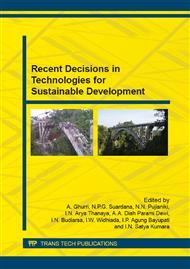[1]
Y-K. Hao, J-Y. Xiao, High performance composite materials, Chem. Industry Press, China, (2004).
Google Scholar
[2]
A-K. Bledzki, J. Gassan, Composites reinforced with cellulose based fibres. Progress in Polymer Sci. 24 (1999) 221–274.
DOI: 10.1016/s0079-6700(98)00018-5
Google Scholar
[3]
Natural fibres make cars greener,. Reinforced Plastics. (2003).
Google Scholar
[4]
International Organization for Standardization, ISO 14040: environmental management—life cycle assessment —principles and framework. (1997).
Google Scholar
[5]
S-V. Joshi, L-T. Drzal, A-K. Mohanty. Are natural fiber composites environmentally superior to glass fiber reinforced composites? Composites: Part A. 35( 2004) 371-376.
DOI: 10.1016/j.compositesa.2003.09.016
Google Scholar
[6]
N-T. Corbiere, B-G. Laban, L. Lundquist, Y. Leterrier, J-A, Manson, O. Jolliet, Lifecycle assessment of biofibers replacing glass fibers as reinforcement in plastics. Resource Conservation Recycling . 33(2001)267–87.
DOI: 10.1016/s0921-3449(01)00089-1
Google Scholar
[7]
W-P. Schmidt, H-M. Beyer, Life cycle study on a natural fiber reinforced component, SAE Technical paper 982195. SAE Total Life-cycle Conf. Graz, Austria; December 1–3, (1998).
DOI: 10.4271/982195
Google Scholar
[8]
J. Diener, U. Siehler, Okologischer vergleich von NMT-und GMTBauteilen, Angew Makromol Chem. 1999; 272(Nr. 4744): 1–4.
DOI: 10.1002/(sici)1522-9505(19991201)272:1<1::aid-apmc1>3.0.co;2-4
Google Scholar
[9]
Wotzel K, Wirth R, Flake R. Life cycle studies on hemp fiber reinforced components and ABS for automotive parts. Angew Makromol Chem 1999; 272(4673): 121–7.
DOI: 10.1002/(sici)1522-9505(19991201)272:1<121::aid-apmc121>3.0.co;2-t
Google Scholar
[10]
M. Goedkoop, Eco-indicator 95-Weighting method for environmental effects that damage ecosystems or human health on a European scale, Report by Pre Consultants and DUIF Consultancy, Netherlands; (1995).
Google Scholar
[11]
I. Boustead, Ecoprofiles of plastics and related intermediates, Association of Plastic manufacturers of Europe (APME) Brussels, Belgium; (2002).
Google Scholar
[12]
W. Paul, I. Jan, I. Verpoest, Natural fibres: can they replace glass in fibre reinforced plastics? Composites Sci. Tech. 63 (2003) 1259–1264.
DOI: 10.1016/s0266-3538(03)00096-4
Google Scholar
[13]
R. Eberle, H. Franze, Modeling the use phase of passenger cars in LCI. SAE Technical Paper 982179, SAE Total Life-cycle Conference, Graz Austria; December 1–3, (1998).
DOI: 10.4271/982179
Google Scholar
[14]
A-C-N. Singletona, C-A. Baillieb, P-W-R. Beaumonta, T. Peijsc, On the mechanical properties, deformation and fracture of a natural fibre/recycled polymer composite, Composites: Part B 34 (2003) 519–526.
DOI: 10.1016/s1359-8368(03)00042-8
Google Scholar
[15]
M. Richardson, Z. Zhang, Nonwoven hemp reinforced composites. Reinf. plastics. 4( 2001).
Google Scholar
[16]
B-V. Voorn, H-H-G. Smit, R-T. Sinke, B-D Klerk, Natural fiber reinforced sheet molding compound. Composites: Part A 32(2001)1271-1279.
DOI: 10.1016/s1359-835x(01)00085-9
Google Scholar
[17]
Y. Li, Y-W. Mai. L. Ye. Sisal fibre and its composites: a review of recent developments. Composites Sci. Tech. 60 (2000) 2037-(2055).
DOI: 10.1016/s0266-3538(00)00101-9
Google Scholar
[18]
A. Nechwatal, K-P. Mieck, T. Reubann. Developments in the characterization of natural fibre properties and in the use of natural fibres for composites, Composites Sci. Tech. 63(2003) 1273–1279.
DOI: 10.1016/s0266-3538(03)00098-8
Google Scholar
[19]
T-M. Gowda, A-C-B. Naidua, R. Chhayab. Some mechanical properties of untreated jute fabric-reinforced polyester composites. Composites: Part A 30 (1999) 277–284.
DOI: 10.1016/s1359-835x(98)00157-2
Google Scholar
[20]
K. Okubo, T. Fujii, Y. Yamamoto, Development of bamboo-based polymer composites and their mechanical properties, Composites: Part A 35 (2004) 377–383.
DOI: 10.1016/j.compositesa.2003.09.017
Google Scholar
[21]
J-Y. Xiao, J-C. Zeng, Status of research and development of high performance natural fiber reinforced composites, J. GFRP. composites, 2(2000).
Google Scholar
[22]
O-L-S. Alsinaa, L-H. Carvalhob, F-G. Filhob, J-R-M. Almeida, Thermal properties of hybrid lignocellulosic fabric-reinforced polyester matrix composites, Polymer Testing 24 (2005) 81–85.
DOI: 10.1016/j.polymertesting.2004.07.005
Google Scholar
[23]
C-H. Chen, Y-C. Wang, Effective thermal conductivity of misoriented short-fiber reinforced thermoplastics. Mechanics Maters. 23 (1996) 217-228.
DOI: 10.1016/0167-6636(96)00010-5
Google Scholar
[24]
New green material for automobile applications, Weaving technology abroad, 10(2003).
Google Scholar
[25]
G-C. Ellison, R. McNaught, The use of natural fibers in nonwoven structures for application as automotive component substrate, Research & Development Report, 2(2000), The Textile Consultancy Ltd.
Google Scholar
[26]
L-Y. Liu, R. Wang, Linen fiber and its applications, J. Industrial textiles, 4(2004)78-81.
Google Scholar
[27]
K-V. Velde, P. Kiekens, Thermoplastic pultrusion of natural fiber reinforced composites, Composite Struc. 54(2001) 355-360.
DOI: 10.1016/s0263-8223(01)00110-6
Google Scholar
[28]
R-H. Hu, Z-G. Ma, S. Zheng, A fabrication process of high volume fraction of jute fiber/polylactide composites for truck liner, Inter. J. Precision Eng. Manuf. 13(2012)1243-1246.
DOI: 10.1007/s12541-012-0165-5
Google Scholar
[29]
R-H. Hu, M-Y Sun, J-K. Lim, Moisture absorption, tensile strength and microstructure evolution of short Jute fiber/polylactide composite in hygrothermal environment, Mater. Design. 31(2010) 3167-3173.
DOI: 10.1016/j.matdes.2010.02.030
Google Scholar


